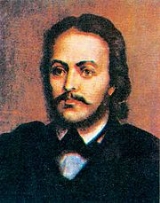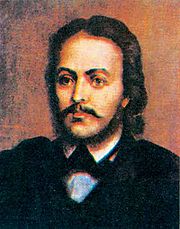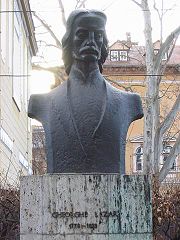
Gheorghe Lazar
Encyclopedia


Avrig
Avrig is a town in the Sibiu County, Romania. It has a population of 16,215 and the first documents attesting the village date to 1346.The town administers four villages: Bradu , Glâmboaca , Mârşa and Săcădate .- Geography :It lies on the left bank of the river Olt Avrig is a town in the Sibiu...
, Sibiu County
Sibiu County
Sibiu is a county of Romania, in the historical region Transylvania, with the capital city Sibiu.-Demographics:In 2002, it had a population of 421,724 and the population density was 78/km²....
, was a Transylvania
Transylvania
Transylvania is a historical region in the central part of Romania. Bounded on the east and south by the Carpathian mountain range, historical Transylvania extended in the west to the Apuseni Mountains; however, the term sometimes encompasses not only Transylvania proper, but also the historical...
n-born Romania
Romania
Romania is a country located at the crossroads of Central and Southeastern Europe, on the Lower Danube, within and outside the Carpathian arch, bordering on the Black Sea...
n scholar, the founder of the first Romanian language
Romanian language
Romanian Romanian Romanian (or Daco-Romanian; obsolete spellings Rumanian, Roumanian; self-designation: română, limba română ("the Romanian language") or românește (lit. "in Romanian") is a Romance language spoken by around 24 to 28 million people, primarily in Romania and Moldova...
school - in Bucharest
Bucharest
Bucharest is the capital municipality, cultural, industrial, and financial centre of Romania. It is the largest city in Romania, located in the southeast of the country, at , and lies on the banks of the Dâmbovița River....
, 1818.
Biography
A Habsburg Empire subject, Lazăr was born in a family of peasants. He studied in SibiuSibiu
Sibiu is a city in Transylvania, Romania with a population of 154,548. Located some 282 km north-west of Bucharest, the city straddles the Cibin River, a tributary of the river Olt...
, Cluj
Cluj-Napoca
Cluj-Napoca , commonly known as Cluj, is the fourth most populous city in Romania and the seat of Cluj County in the northwestern part of the country. Geographically, it is roughly equidistant from Bucharest , Budapest and Belgrade...
, and Vienna
Vienna
Vienna is the capital and largest city of the Republic of Austria and one of the nine states of Austria. Vienna is Austria's primary city, with a population of about 1.723 million , and is by far the largest city in Austria, as well as its cultural, economic, and political centre...
, training in theology
Theology
Theology is the systematic and rational study of religion and its influences and of the nature of religious truths, or the learned profession acquired by completing specialized training in religious studies, usually at a university or school of divinity or seminary.-Definition:Augustine of Hippo...
, but also interested in history and philosophy. The strong admiration he had for Napoleon I
Napoleon I
Napoleon Bonaparte was a French military and political leader during the latter stages of the French Revolution.As Napoleon I, he was Emperor of the French from 1804 to 1815...
, as well as other radical opinions he expressed, prevented him from becoming a priest. He later had to flee for Wallachia
Wallachia
Wallachia or Walachia is a historical and geographical region of Romania. It is situated north of the Danube and south of the Southern Carpathians...
, where he worked as a tutor and engineer, drawing admiration from boyar
Boyar
A boyar, or bolyar , was a member of the highest rank of the feudal Moscovian, Kievan Rus'ian, Bulgarian, Wallachian, and Moldavian aristocracies, second only to the ruling princes , from the 10th century through the 17th century....
Constantin Bălăceanu, who was charged with the administration of schools throughout the Principality.
His school signified the break with a tradition of schooling in Greek
Greek language
Greek is an independent branch of the Indo-European family of languages. Native to the southern Balkans, it has the longest documented history of any Indo-European language, spanning 34 centuries of written records. Its writing system has been the Greek alphabet for the majority of its history;...
(prevalent under Phanariote rule), and also marked a step towards secularism
Secularism
Secularism is the principle of separation between government institutions and the persons mandated to represent the State from religious institutions and religious dignitaries...
in education. Lazăr was one of the first wave of Romanian Transylvanian teachers to shape schooling in both Wallachia and Moldavia
Moldavia
Moldavia is a geographic and historical region and former principality in Eastern Europe, corresponding to the territory between the Eastern Carpathians and the Dniester river...
throughout the 19th century.
In 1821 he became gravely ill, and returned to his home village where he died.
Legacy
Today a great number of Romanian highschools are named in his honour. The most prestigious are:- The Gheorghe Lazăr National College in Bucharest - formed after reorganisation of his first school.
- The Gheorghe Lazăr National College in Sibiu - a school Gheorghe Lazăr himself attended in 1801-1802.
A commune (Gheorghe Lazăr
Gheorghe Lazar, Ialomita
Gheorghe Lazăr is a commune located in Ialomiţa County, Romania. It is composed of a single village, Gheorghe Lazăr.-References:...
) in Ialomiţa County
Ialomita County
Ialomița is a county of Romania, in Muntenia, with the capital city at Slobozia.-Demographics:In 2002, it had a population of 296,572 and the population density was 67/km²....
was named after him.
A statue of him was erected in Bucharest's University Square
University Square, Bucharest
University Square is located in downtown Bucharest, near the University of Bucharest.Four statues are located in the University Square, in front of the University; they depict Ion Heliade Rădulescu , Michael the Brave , Gheorghe Lazăr and Spiru Haret .The square was the site of the 1990 Golaniad,...
, standing in front of the University of Bucharest
University of Bucharest
The University of Bucharest , in Romania, is a university founded in 1864 by decree of Prince Alexander John Cuza to convert the former Saint Sava Academy into the current University of Bucharest.-Presentation:...
. The one erected during the communist regime
Communist Romania
Communist Romania was the period in Romanian history when that country was a Soviet-aligned communist state in the Eastern Bloc, with the dominant role of Romanian Communist Party enshrined in its successive constitutions...
in Sibiu's main square, controversial because of its Socialist Realist
Socialist realism
Socialist realism is a style of realistic art which was developed in the Soviet Union and became a dominant style in other communist countries. Socialist realism is a teleologically-oriented style having its purpose the furtherance of the goals of socialism and communism...
style, was removed and is due to be replaced with a more conventional portrait.

